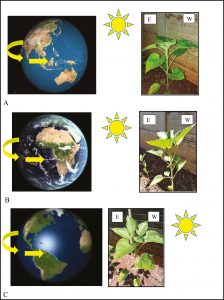Challenging current interpretation of sunflower movements (J. Exp. Bot)
 Plants are vigorous and sensitive organisms that can move various organs: leaves, shoots, tendrils, flower petals and roots. Movements in plants are usually regarded as a response to an environmental stimulus, such as light, temperature, or gravity. However, plants also are capable of autonomous, endogenous movements without apparent stimuli, and these movements can also exhibit a specific rhythm. Sunflower movements are generally described as heliotropic, with leaves and flower heads that track the sun during the day, regulated by an internal rhythm of gene expression. In this paper the authors took the generally believed idea that “sunflowers track the sun” with a grain of salt because the rotation of the earth around its own axis, gravity and gravitation are always not taken into consideration. The authors discuss the various ways that heliotropism and gravitropism have been defined, dispute the notion that sunflowers follow the Sun’s movement (they observe that the sun is fixed in space, whilst the plant is fixed on a rotating Earth), and how gravity contributes to resetting the position. The authors suggest that phototropism is a better explanation for sunflower movement. (Summarized by Francesca Resentini). J. Exp. Bot. 10.1093/jxb/erz381/5554344
Plants are vigorous and sensitive organisms that can move various organs: leaves, shoots, tendrils, flower petals and roots. Movements in plants are usually regarded as a response to an environmental stimulus, such as light, temperature, or gravity. However, plants also are capable of autonomous, endogenous movements without apparent stimuli, and these movements can also exhibit a specific rhythm. Sunflower movements are generally described as heliotropic, with leaves and flower heads that track the sun during the day, regulated by an internal rhythm of gene expression. In this paper the authors took the generally believed idea that “sunflowers track the sun” with a grain of salt because the rotation of the earth around its own axis, gravity and gravitation are always not taken into consideration. The authors discuss the various ways that heliotropism and gravitropism have been defined, dispute the notion that sunflowers follow the Sun’s movement (they observe that the sun is fixed in space, whilst the plant is fixed on a rotating Earth), and how gravity contributes to resetting the position. The authors suggest that phototropism is a better explanation for sunflower movement. (Summarized by Francesca Resentini). J. Exp. Bot. 10.1093/jxb/erz381/5554344



